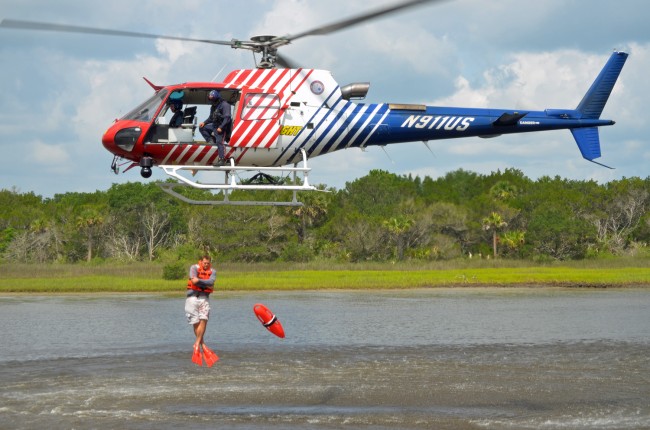
Dana Morris pilots Fire Flight—Flagler County’s emergency helicopter—to what looked like an ideal landing pad next to the boat launch at Bing’s Landing. A rescue swimmer runs out to the chopper, get strapped in on its deck. The chopper takes off, making a large arc about a half mile north over the Intracoastal, with boat traffic stopped at either end of the training area as Fire Flight hovers back down above the water, 30, 40 or 50 feet high. The swimmer jumps out, rescue bouee and feet first, to be himself picked up by another rescuer speeding in on a jet-ski below. As Fire Flight returns to the landing pad, Intracoastal traffic is reopened for a couple of minutes, then closed again for another helicopter run.
So it went all morning and into early afternoon Wednesday as Fire Flight, the Flagler County Sheriff’s Office, the Florida Fish and Wildlife Conservation Commission (which provided traffic control on the Intracoastal) and Flagler County Fire Rescue teamed up to train 10 Flagler firefighters and five sheriff’s deputies in a technique that will vastly enhance authorities’ speedy rescue capabilities in case of waterborne accidents offshore. The exercise was also a rare, public look at the county’s first responders in close-up action–time, perhaps not coincidentally, with the county’s budget wrangles, which have hinted at crimping rescue operations.
“Basically this is going to be another component of our marine rescue team,” Flagler County Fire Chief Don Petito said. Twenty-eight of the department’s 75 firefighter-paramedics and lieutenants are certified members in marine rescue. Petito wants to double that number. He also wants to have numerous rescuers trained in jumping from the helicopter.
“Those guys are rescue swimmers,” Petito said. “So what this basically is going to do is allow for a quick access rescue swimmer before a watercraft can get out to the victim in the water. So we have enough guys trained now to where we can actually deploy a rescue swimmer from Station 92 where the helicopter is docked, at the airport. The watercraft is stationed at the Hammock. We can go ahead and deploy the rescue swimmer on the watercraft from the Hammock. So you have two different areas that are going to be responding at the same time.”
Aaron Price, who’s been with Fire Rescue eight years, is the team leader for the Marine Rescue Division. He was on the jet ski today, retrieving swimmer after swimmer, while communicating through his marine radio with shore and the helicopter.
“They’re jumping five times each,” he said. “The reason for that is so they can become proficient at it, and they know the process, and they feel comfortable and they’re also jumping from varying heights. Depending on the conditions they may have to go higher. If there’s high waves that day the helicopter obviously can’t come in that low, so we let them jump from varying heights in order to adjust their comfort level with heights and such.”
Dennis Moore, 25, of Palm Coast, based at Station 41 in the Hammock, was among the swimmers training today. “It’s an adrenaline rush. It’s not a normal thing to sit on the edge of an aircraft and be out there,” Moore said shortly after a jump. “You have a little lap belt on, you’re belted in safe, pretty much, but the wind rushing through you, I guess it’s kind of like a motorcycle, a couple of hundred feet in the air.” He had done three jumps so far, and went through the check-list of factors to keep in mind during each jump. It’s not a matter of just sitting on the deck and waiting for two taps on the shoulder.
“You’re thinking about where your patient is going to be,” Moore says, “where you want to land, current-wise, is it going to bring you to your patient, is it going to bring you away, where our equipment is going to land with you, how you’re going to jump and land, because you don’t want to jump wrong and hurt yourself.”
He spoke while Morris, the pilot, and swimmers took a break for debriefing, and to exchange pointers and what to try next.
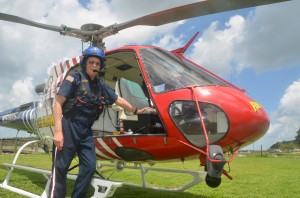
Morris described in detail the moment-by-moment exercise: “A flight medic is sitting in the helicopter with the pilot. “He gets on the helicopter, and then he hands his bouee to the flight medic, he buckles into his safety belt, then after that gives the thumbs up that he’s OK. Then the flight medic verifies that he’s buckled in, he verifies that the gunner’s belt that he’s buckled into is [locked] into the seatbelt, then he verifies that the cabin’s clear,” clears left, clears right, and the pilot takes off. When he’s in the air and ready to jump, the swimmer gets two taps, the medic undoes the belt, and the swimmer jumps.”
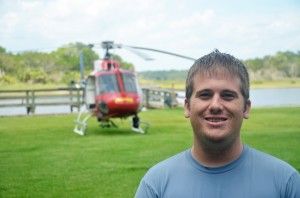
The training appeared to go flawlessly throughout the day. (The helicopter was back at the airport at 2:30 p.m.) Today’s training was conducted in the relatively safe and controlled environment of the Intracoastal, under light winds and weather conditions leisurely enough that kayakers and boaters jammed the waterway, when they were allowed to pass. But it’s the ocean swimmers must be ready for. That’ll be next. Fire Flight doesn’t spend unnecessary time too close to the ocean surface because salt wears on the helicopter’s machinery.
“We’re working right now in a really safe environment to get all the procedures down,” Morris said. “That’s the whole point of it is do it out in the ocean, but the problem with doing it out in the ocean is a lot of wear and tear on the engine of this thing, so we want to get everything done on the Intracoastal here in a safe environment with no surf. Once we get it down, everybody is comfortable with it, we have the procedures down, then we’re going to go out and do some testing in the surf.”
Once in place, the combined capabilities of helicopter and waterborne rescues will close what had been a gap in rapid emergency responses on the water.
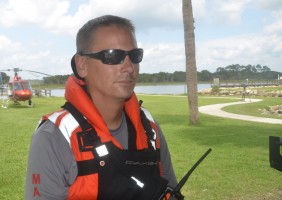
Price couldn’t note a situation that involved a rescue where the absence of a helicopter-borne swimmer proved to be a critically missing link. “So far we’ve been pretty good, have been able to respond as quickly as we need to, without the helicopter,” he said. “We always have the Polaris and the jet-ski available, 24 hours a day, seven days a week. It runs out of our Hammock Station which is Station 41.”
That doesn’t mean improving rescue capabilities to include Fire Flight isn’t necessary. “The jet ski is restricted to how far it can go. Obviously it’s not safe to put the jet ski out of, let’s say, line of sight, out into the ocean. That’s where the helicopter would come in. If you have let’s say a boat that’s three miles off shore and it’s taking on water, it’s going down, and they’ve got passengers on board, the helicopter could fly out the rescue swimmer. If you notice when the rescue swimmer jumps from the helicopter, he has a red bouee in his hand, that red bouee is capable of floating six people. So what he would do then, he has on a life vest, so he’s already floatable, he would give off that bouee and allow up to six people to grab on to that bouee, and that’ll keep them afloat until we can get better resources to them to get them to shore.” Most likely, a Flagler County Sheriff’s rescue boat, Fish and Wildlife or the Coast Guard.
Such rescues aren’t expected to be needed “real frequently,” Petito said, “but it’s something we have in the tool bag just in case.”
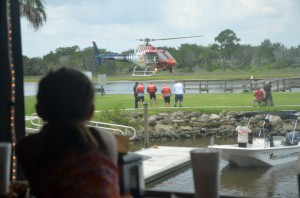
“That’s just to even take the class,” Price says. “During the class, we start off every day—it’s a 40-hour class for the Operations Level, and every day they start off with about an 1,800-meter swim. During that class they actually do complete a one-mile swim in the ocean.” That one isn’t timed. “They just have to be able to complete it.” Class consists of half the day swimming in the pool, and the rest of the day working on techniques in the ocean. “Everybody on the team has been overly enthusiastic about doing this, and I haven’t had anybody yet that has said they don’t want to do it.”
Numerous visitors passed through Bings Landing—a county park—during the exercise, stopping at Mike Goodman’s Captain’s BBQ, which opened there last year. Many watched the helicopter take off and land time after time from ideal mezzanine seats as they had lunch on the deck of the restaurant. But it’s not as if business picked up particularly: the county hadn’t announced the training, and State Road A1A has been a clutter of construction and repaving, diminishing traffic to Bing’s Landing, if anything. Goodman wasn’t complaining.
“Everyone in the park is real impressed with our state of readiness,” Goodman said, referring to the rescue capabilities. As for Captain’s BBQ? “Slowly but surely, more people are coming into the park,” he said. “Business can always be better, but for the first year I’m OK with it.” He called it “a work of love.” Firefighters and cops, who aren’t paid much, might say the same thing about their job, especially today.
![]()
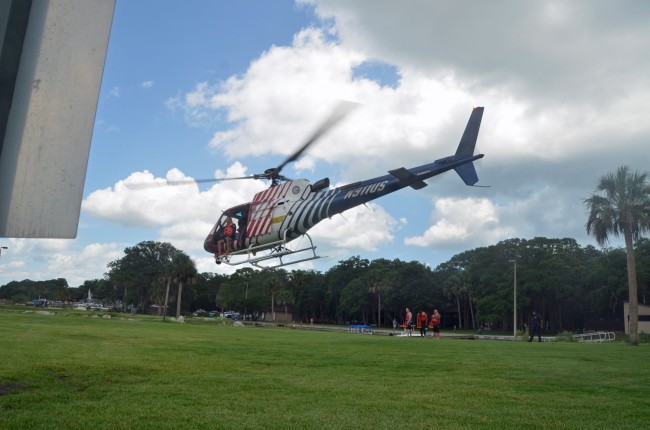
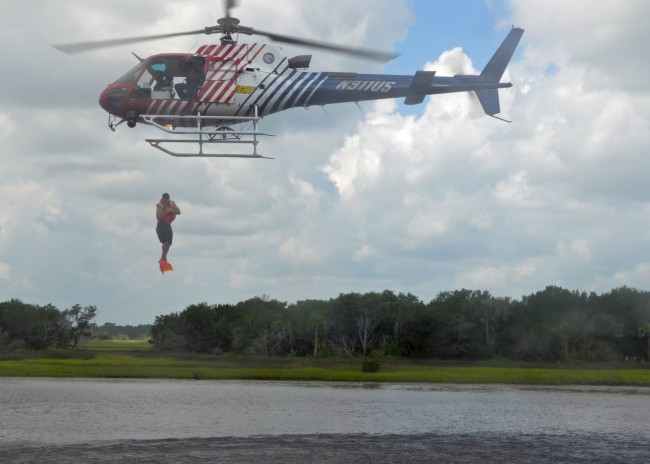
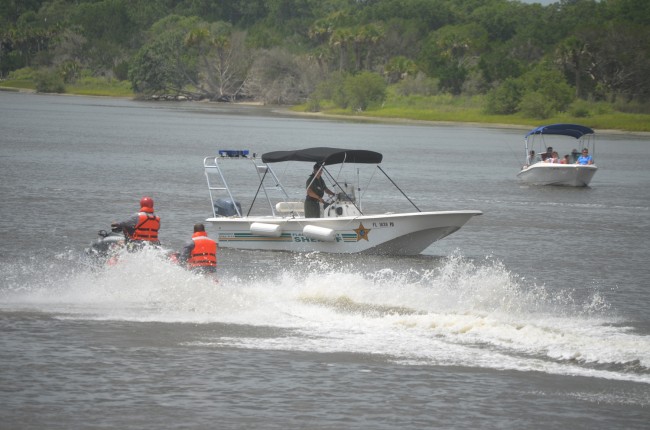
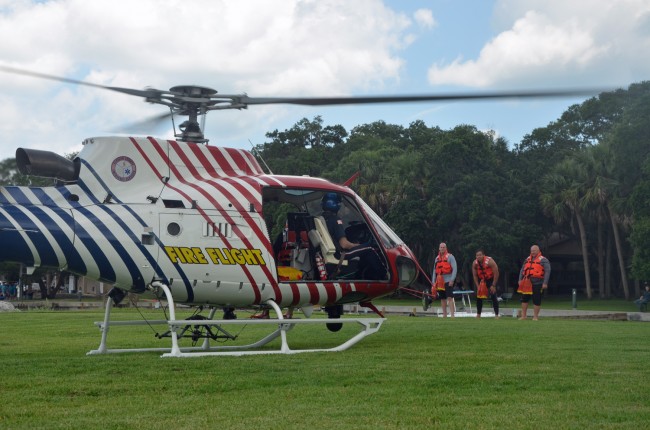
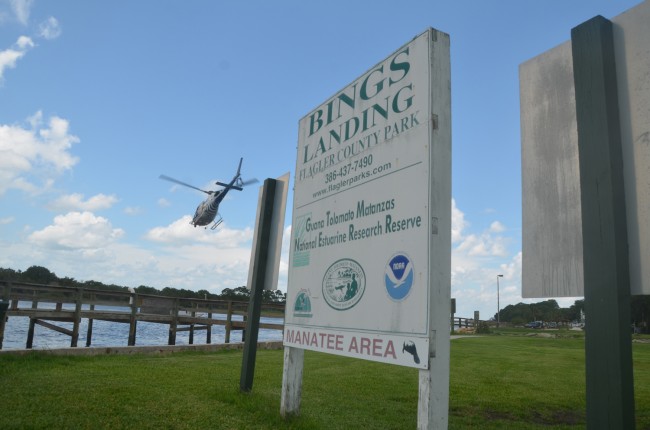




























Leave a Reply